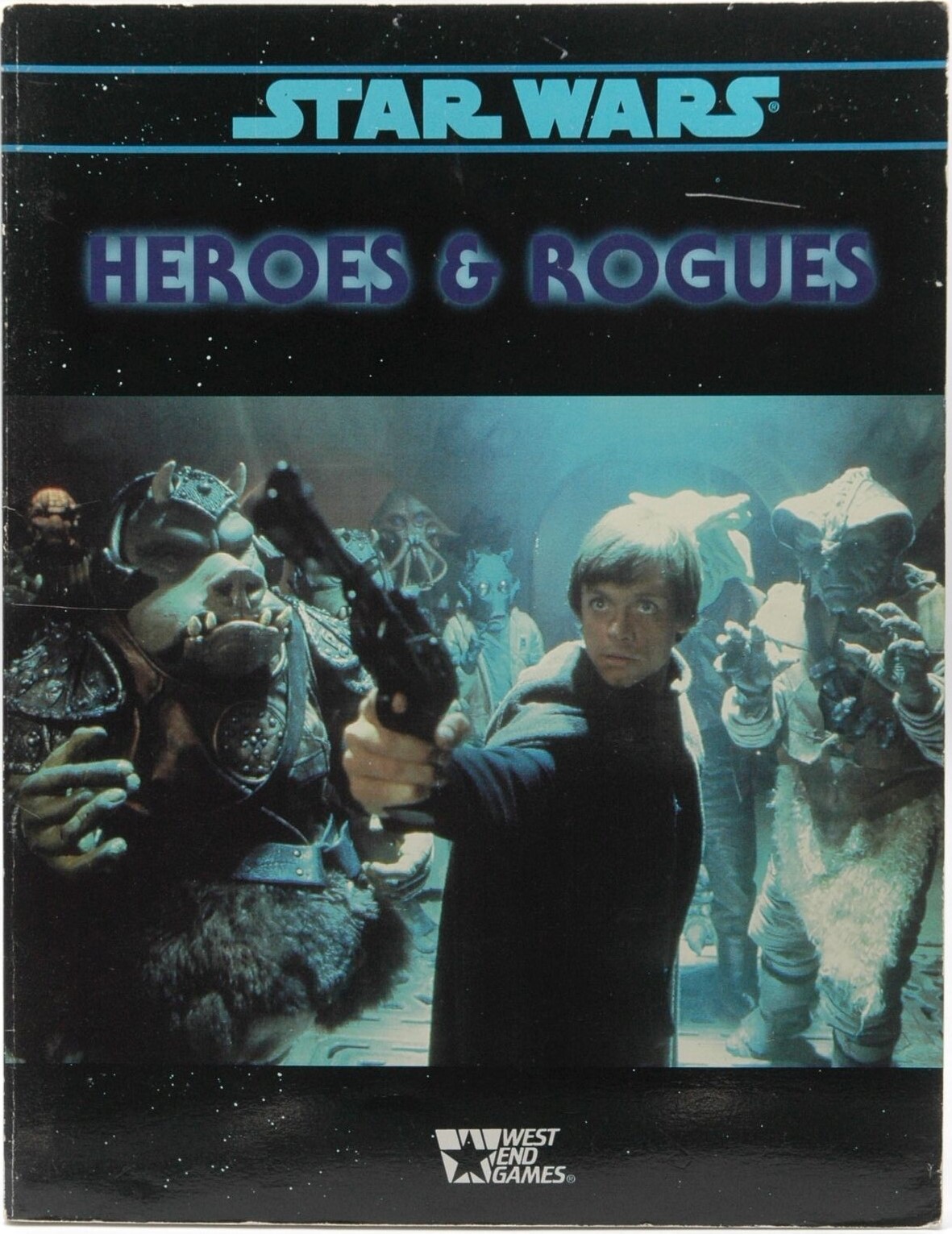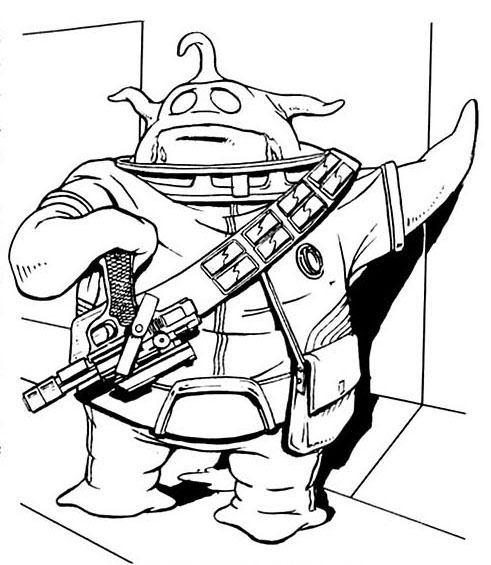Love is in the air currently. Star Wars is back, and it's oh, so cool. The original trilogy and the new films are on fans' minds.
As a gamer, it reminds me of that day I walked into my FLGS and saw a brand new hard bound. Star Wars The Roleplaying Game! Published by West End Games. Powered by D6. I picked it up, flipped through it, and fell deeply in love.
I was slight on cash, as this was the late 80's, and I was young. I walked out of the store, looked at my girlfriend, and asked her if I could borrow a few bucks. I couldn't leave without buying the game.
To this day, Star Wars, first edition, is (as I have said many times) what I consider one of the best marriages between mechanics and roleplaying milieu that has ever been created. The rules serve the game--provide atmosphere for the game--like few other game systems.
And, it's so damned simple. The entire game can be taught in minutes. Players need to know NOTHING about the rules. They can learn as they go, and they'll know all they need to know after playing a single game session.
I'm not talking about the rules the D6 Star Wars became afterwards. I'm talking about the basic rules. The First Edition only.
Ya see, the rules were modified several times over the years. I'll admit that I like every incarnation of the game. But, as the modifications came, the game became more complicated. I like crunch, as long as it flows and doesn't bog the game down, and even the crunchiest version of the D6 Star Wars rules flow like oil down a beautiful woman's behind. But, there's just something about that First Edition that holds a special place in my heart.
If you've got that Star Wars mood nagging at you, and you want to put together a quick game, then Star Wars First Edition is your friend. You can find the original rulebook on the net. I've seen it at several places. You can also buy a copy for a reasonable price on eBay. The book is hardback, and it is quite pretty. I love the fake advertisements that WEG placed in the book.
The basic concept is this: Whenever a task is rolled, a number of D6 dice are thrown against a target number. The game only uses D6 dice. Sometimes, a task is rolled against another few or several D6 dice in place of a target.
As with most skill based games, character attributes govern skills. In this game, a skill or attribute is given a die code. When you need to roll, you just roll the die code.
The average code for human attributes is 2D, and humans typically range from 1D to 4D. For example, an average human would have Dexterity 2D. Whenever a test of Dex is necessary in the game, the player rolls 2D6. Simple, right?
Dexterity governs the Blaster skill. So, if a character fires a blaster and doesn't have an improved Blaster skill, the character just rolls on his Dexterity. A human with average Dex but without improved Blaster skill would throw 2D6 when he fires a blaster. If the character has improved the Blaster skill, then he would throw whatever his Blaster skill code happens to be. Maybe the character has Dexterity 2D but Blaster skill is 3D.
Character creation is a simple matter of assigning dice to stats and skills. There are six attributes, with each attribute governing several skills. A character without an improved skill can always throw the dice indicated by the governor attribute--or, he throws the dice code for the improved skill, whichever is higher.
What you see above are the six attributes (in caps) and any improved skill governed by that attribute. If Roark needs to roll his DEX to keep from falling off a ledge, he rolls 3D+1. If Roark fires his Blaster, he rolls 5D+1. If Roark attempts to reprogram an R2 unit, he'd use the Droid Program and Repair skill. But, Roark hasn't improved that skill. Therefore, it defaults to the skill governor, which is, in this case, Technical. Roark would throw 2D+2 on the task. How simple is that?
There are rules for creating droids and aliens as well as various types of humans, but that's an advanced rule. The simple way to go is to use one of the several character templates provided with the game rules. These are characters that are just about complete. All that is needed is some customization. A player is given a number of D6 to add to the template, thereby individualizing the character, and he's ready to go.
At the start of a game with complete newbies (those who have never played a D6 Star Wars Game before), the GM can allow players to pick from a selection of templates. The GM may even throw in some templates that he has created specifically for the adventure. The players pick a template, customize it with the bonus dice, and, boom, character generation and equipment selection is done. And, it's done in like....ten minutes. Boom. All done. Let's play.
As a gamer, it reminds me of that day I walked into my FLGS and saw a brand new hard bound. Star Wars The Roleplaying Game! Published by West End Games. Powered by D6. I picked it up, flipped through it, and fell deeply in love.
I was slight on cash, as this was the late 80's, and I was young. I walked out of the store, looked at my girlfriend, and asked her if I could borrow a few bucks. I couldn't leave without buying the game.
To this day, Star Wars, first edition, is (as I have said many times) what I consider one of the best marriages between mechanics and roleplaying milieu that has ever been created. The rules serve the game--provide atmosphere for the game--like few other game systems.
And, it's so damned simple. The entire game can be taught in minutes. Players need to know NOTHING about the rules. They can learn as they go, and they'll know all they need to know after playing a single game session.
I'm not talking about the rules the D6 Star Wars became afterwards. I'm talking about the basic rules. The First Edition only.
Ya see, the rules were modified several times over the years. I'll admit that I like every incarnation of the game. But, as the modifications came, the game became more complicated. I like crunch, as long as it flows and doesn't bog the game down, and even the crunchiest version of the D6 Star Wars rules flow like oil down a beautiful woman's behind. But, there's just something about that First Edition that holds a special place in my heart.
D6 Star Wars Rules Editions
Star Wars First Edition
Star Wars First Edition + Rules Upgrade
Star Wars First Edition + Rules Companion
Star Wars Second Edition
Star Wars Second Edition Revised and Expanded
D6 Space (released for free by the publisher on the net)
Star Wars Revised and Expanded & Updated (fan made ultimate culmination of rules)
Star Wars First Edition
Star Wars First Edition + Rules Upgrade
Star Wars First Edition + Rules Companion
Star Wars Second Edition
Star Wars Second Edition Revised and Expanded
D6 Space (released for free by the publisher on the net)
Star Wars Revised and Expanded & Updated (fan made ultimate culmination of rules)
If you've got that Star Wars mood nagging at you, and you want to put together a quick game, then Star Wars First Edition is your friend. You can find the original rulebook on the net. I've seen it at several places. You can also buy a copy for a reasonable price on eBay. The book is hardback, and it is quite pretty. I love the fake advertisements that WEG placed in the book.
The basic concept is this: Whenever a task is rolled, a number of D6 dice are thrown against a target number. The game only uses D6 dice. Sometimes, a task is rolled against another few or several D6 dice in place of a target.
As with most skill based games, character attributes govern skills. In this game, a skill or attribute is given a die code. When you need to roll, you just roll the die code.
Die Code Progression
1D
1D +1
1D +2
2D
2D +1
2D +2
3D
And so on...
1D
1D +1
1D +2
2D
2D +1
2D +2
3D
And so on...
The average code for human attributes is 2D, and humans typically range from 1D to 4D. For example, an average human would have Dexterity 2D. Whenever a test of Dex is necessary in the game, the player rolls 2D6. Simple, right?
Dexterity governs the Blaster skill. So, if a character fires a blaster and doesn't have an improved Blaster skill, the character just rolls on his Dexterity. A human with average Dex but without improved Blaster skill would throw 2D6 when he fires a blaster. If the character has improved the Blaster skill, then he would throw whatever his Blaster skill code happens to be. Maybe the character has Dexterity 2D but Blaster skill is 3D.
Character creation is a simple matter of assigning dice to stats and skills. There are six attributes, with each attribute governing several skills. A character without an improved skill can always throw the dice indicated by the governor attribute--or, he throws the dice code for the improved skill, whichever is higher.
Sample Character
Roark Garnet
28 year old Smuggler
6' and 180 lbs.
Force Points = 1
DEXTERITY 3D+1
Blaster 5D+1
Dodge 4D+1
KNOWLEDGE 2D+1
MECHANICAL 3D+2
Starship Piloting 5D+2
PERCEPTION 3D
Bargain 4D
STRENGTH 3D
Brawling 4D
TECHNICAL 2D+2
Roark Garnet
28 year old Smuggler
6' and 180 lbs.
Force Points = 1
DEXTERITY 3D+1
Blaster 5D+1
Dodge 4D+1
KNOWLEDGE 2D+1
MECHANICAL 3D+2
Starship Piloting 5D+2
PERCEPTION 3D
Bargain 4D
STRENGTH 3D
Brawling 4D
TECHNICAL 2D+2
What you see above are the six attributes (in caps) and any improved skill governed by that attribute. If Roark needs to roll his DEX to keep from falling off a ledge, he rolls 3D+1. If Roark fires his Blaster, he rolls 5D+1. If Roark attempts to reprogram an R2 unit, he'd use the Droid Program and Repair skill. But, Roark hasn't improved that skill. Therefore, it defaults to the skill governor, which is, in this case, Technical. Roark would throw 2D+2 on the task. How simple is that?
There are rules for creating droids and aliens as well as various types of humans, but that's an advanced rule. The simple way to go is to use one of the several character templates provided with the game rules. These are characters that are just about complete. All that is needed is some customization. A player is given a number of D6 to add to the template, thereby individualizing the character, and he's ready to go.
At the start of a game with complete newbies (those who have never played a D6 Star Wars Game before), the GM can allow players to pick from a selection of templates. The GM may even throw in some templates that he has created specifically for the adventure. The players pick a template, customize it with the bonus dice, and, boom, character generation and equipment selection is done. And, it's done in like....ten minutes. Boom. All done. Let's play.





